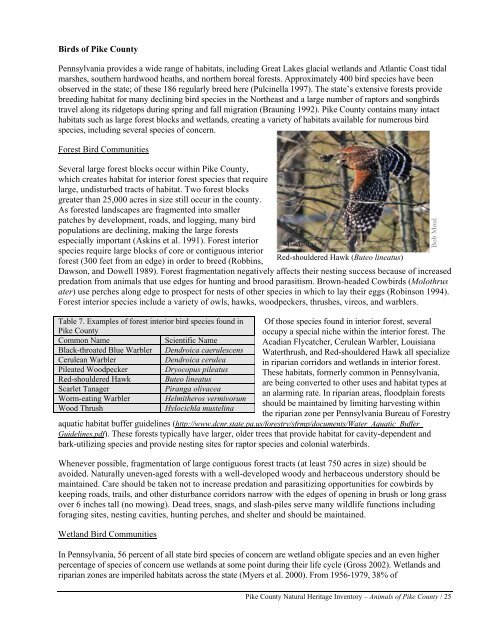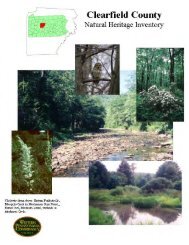Pike CNHI - Pennsylvania Natural Heritage Program
Pike CNHI - Pennsylvania Natural Heritage Program
Pike CNHI - Pennsylvania Natural Heritage Program
You also want an ePaper? Increase the reach of your titles
YUMPU automatically turns print PDFs into web optimized ePapers that Google loves.
Birds of <strong>Pike</strong> County<br />
<strong>Pennsylvania</strong> provides a wide range of habitats, including Great Lakes glacial wetlands and Atlantic Coast tidal<br />
marshes, southern hardwood heaths, and northern boreal forests. Approximately 400 bird species have been<br />
observed in the state; of these 186 regularly breed here (Pulcinella 1997). The state’s extensive forests provide<br />
breeding habitat for many declining bird species in the Northeast and a large number of raptors and songbirds<br />
travel along its ridgetops during spring and fall migration (Brauning 1992). <strong>Pike</strong> County contains many intact<br />
habitats such as large forest blocks and wetlands, creating a variety of habitats available for numerous bird<br />
species, including several species of concern.<br />
Forest Bird Communities<br />
Several large forest blocks occur within <strong>Pike</strong> County,<br />
which creates habitat for interior forest species that require<br />
large, undisturbed tracts of habitat. Two forest blocks<br />
greater than 25,000 acres in size still occur in the county.<br />
As forested landscapes are fragmented into smaller<br />
patches by development, roads, and logging, many bird<br />
populations are declining, making the large forests<br />
especially important (Askins et al. 1991). Forest interior<br />
species require large blocks of core or contiguous interior<br />
forest (300 feet from an edge) in order to breed (Robbins,<br />
Red-shouldered Hawk (Buteo lineatus)<br />
Dawson, and Dowell 1989). Forest fragmentation negatively affects their nesting success because of increased<br />
predation from animals that use edges for hunting and brood parasitism. Brown-headed Cowbirds (Molothrus<br />
ater) use perches along edge to prospect for nests of other species in which to lay their eggs (Robinson 1994).<br />
Forest interior species include a variety of owls, hawks, woodpeckers, thrushes, vireos, and warblers.<br />
Table 7. Examples of forest interior bird species found in<br />
<strong>Pike</strong> County<br />
Common Name Scientific Name<br />
Black-throated Blue Warbler Dendroica caerulescens<br />
Cerulean Warbler Dendroica cerulea<br />
Pileated Woodpecker Dryocopus pileatus<br />
Red-shouldered Hawk Buteo lineatus<br />
Scarlet Tanager Piranga olivacea<br />
Worm-eating Warbler Helmitheros vermivorum<br />
Wood Thrush Hylocichla mustelina<br />
Of those species found in interior forest, several<br />
occupy a special niche within the interior forest. The<br />
Acadian Flycatcher, Cerulean Warbler, Louisiana<br />
Waterthrush, and Red-shouldered Hawk all specialize<br />
in riparian corridors and wetlands in interior forest.<br />
These habitats, formerly common in <strong>Pennsylvania</strong>,<br />
are being converted to other uses and habitat types at<br />
an alarming rate. In riparian areas, floodplain forests<br />
should be maintained by limiting harvesting within<br />
the riparian zone per <strong>Pennsylvania</strong> Bureau of Forestry<br />
aquatic habitat buffer guidelines (http://www.dcnr.state.pa.us/forestry/sfrmp/documents/Water_Aquatic_Buffer_<br />
Guidelines.pdf). These forests typically have larger, older trees that provide habitat for cavity-dependent and<br />
bark-utilizing species and provide nesting sites for raptor species and colonial waterbirds.<br />
Whenever possible, fragmentation of large contiguous forest tracts (at least 750 acres in size) should be<br />
avoided. <strong>Natural</strong>ly uneven-aged forests with a well-developed woody and herbaceous understory should be<br />
maintained. Care should be taken not to increase predation and parasitizing opportunities for cowbirds by<br />
keeping roads, trails, and other disturbance corridors narrow with the edges of opening in brush or long grass<br />
over 6 inches tall (no mowing). Dead trees, snags, and slash-piles serve many wildlife functions including<br />
foraging sites, nesting cavities, hunting perches, and shelter and should be maintained.<br />
Wetland Bird Communities<br />
In <strong>Pennsylvania</strong>, 56 percent of all state bird species of concern are wetland obligate species and an even higher<br />
percentage of species of concern use wetlands at some point during their life cycle (Gross 2002). Wetlands and<br />
riparian zones are imperiled habitats across the state (Myers et al. 2000). From 1956-1979, 38% of<br />
<strong>Pike</strong> County <strong>Natural</strong> <strong>Heritage</strong> Inventory – Animals of <strong>Pike</strong> County / 25<br />
Bob Moul










